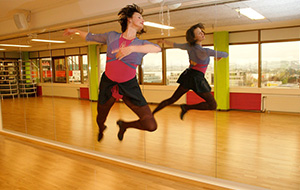 Mirrors in dance studios can be both a help and a hindrance. On one hand they can promote the aspiration towards a high level of technique in being able to observe the body as it works, yet equally it can encourage an unhealthy relationship with the body and what is capable of doing. Being aware of the body’s alignments is ultimately useful in working correctly and safely with good technique, its feedback being beneficial to a dancer’s training and daily routine.
Mirrors in dance studios can be both a help and a hindrance. On one hand they can promote the aspiration towards a high level of technique in being able to observe the body as it works, yet equally it can encourage an unhealthy relationship with the body and what is capable of doing. Being aware of the body’s alignments is ultimately useful in working correctly and safely with good technique, its feedback being beneficial to a dancer’s training and daily routine.
However mirrors can seem ever-present for dancers. For those that are young and susceptible to influence, this could have a detrimental effect on dancers’ abilities to abandon themselves in dance and trust their own bodies. Mirrors may equally encourage dancers to be too focused on their efforts in the studio: a large part of dance is also enjoying the movement and performing it, rather than being caught up with technique constantly.
This begs the question as to whether dancers learn better by observing themselves in the mirror to utilise correct technique, or whether it is best to learn without mirrors, to feel the movement and learn the movement sensations that way. This of course depends on whether there is an option of mirrors at all in a dance studio, and whether using them actually means dancers are just creating shapes rather than working the movement from the inside out.
Mirrors can be so prevalent in dance today, however, that it could be that dancers are so visually stimulated they increasingly rely on mirrors for visual feedback, rather than personally feeling corrections. Additionally mirrors can be used to keep in time with the other dancers in the room and even copy what they are doing, rather than trusting the body and listening to the music to create the same effect. Dancers can spend hours in front of mirrors, analysing their reflection and it can be easy to become overly critical and obsessive.
